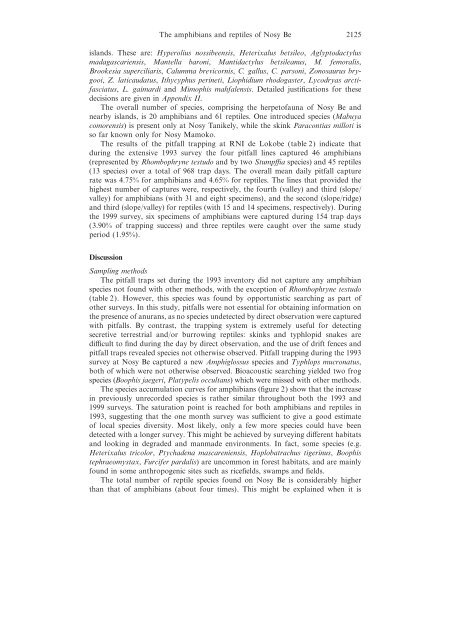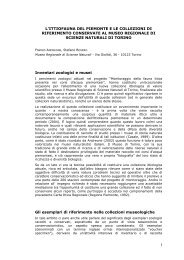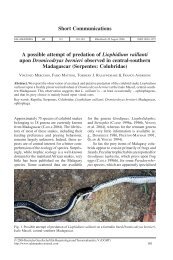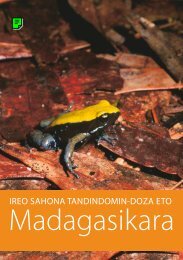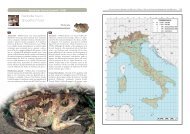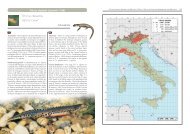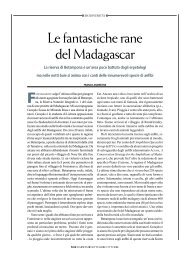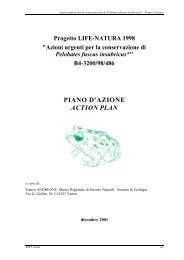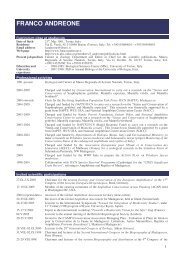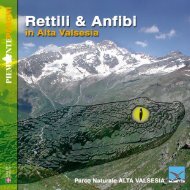The amphibians and reptiles of Nosy Be (NW Madagascar) and ...
The amphibians and reptiles of Nosy Be (NW Madagascar) and ...
The amphibians and reptiles of Nosy Be (NW Madagascar) and ...
You also want an ePaper? Increase the reach of your titles
YUMPU automatically turns print PDFs into web optimized ePapers that Google loves.
<strong>The</strong> <strong>amphibians</strong> <strong>and</strong> <strong>reptiles</strong> <strong>of</strong> <strong>Nosy</strong> <strong>Be</strong> 2125isl<strong>and</strong>s. <strong>The</strong>se are: Hyperolius nossibeensis, Heterixalus betsileo, Aglyptodactylusmadagascariensis, Mantella baroni, Mantidactylus betsileanus, M. femoralis,Brookesia superciliaris, Calumma brevicornis, C. gallus, C. parsoni, Zonosaurus brygooi,Z. laticaudatus, Ithycyphus perineti, Liophidium rhodogaster, Lycodryas arctifasciatus,L. gaimardi <strong>and</strong> Mimophis mahfalensis. Detailed justifications for thesedecisions are given in Appendix II.<strong>The</strong> overall number <strong>of</strong> species, comprising the herpet<strong>of</strong>auna <strong>of</strong> <strong>Nosy</strong> <strong>Be</strong> <strong>and</strong>nearby isl<strong>and</strong>s, is 20 <strong>amphibians</strong> <strong>and</strong> 61 <strong>reptiles</strong>. One introduced species (Mabuyacomorensis) is present only at <strong>Nosy</strong> Tanikely, while the skink Paracontias milloti isso far known only for <strong>Nosy</strong> Mamoko.<strong>The</strong> results <strong>of</strong> the pitfall trapping at RNI de Lokobe (table 2) indicate thatduring the extensive 1993 survey the four pitfall lines captured 46 <strong>amphibians</strong>(represented by Rhombophryne testudo <strong>and</strong> by two Stumpffia species) <strong>and</strong> 45 <strong>reptiles</strong>(13 species) over a total <strong>of</strong> 968 trap days. <strong>The</strong> overall mean daily pitfall capturerate was 4.75% for <strong>amphibians</strong> <strong>and</strong> 4.65% for <strong>reptiles</strong>. <strong>The</strong> lines that provided thehighest number <strong>of</strong> captures were, respectively, the fourth (valley) <strong>and</strong> third (slope/valley) for <strong>amphibians</strong> (with 31 <strong>and</strong> eight specimens), <strong>and</strong> the second (slope/ridge)<strong>and</strong> third (slope/valley) for <strong>reptiles</strong> (with 15 <strong>and</strong> 14 specimens, respectively). Duringthe 1999 survey, six specimens <strong>of</strong> <strong>amphibians</strong> were captured during 154 trap days(3.90% <strong>of</strong> trapping success) <strong>and</strong> three <strong>reptiles</strong> were caught over the same studyperiod (1.95%).DiscussionSampling methods<strong>The</strong> pitfall traps set during the 1993 inventory did not capture any <strong>amphibians</strong>pecies not found with other methods, with the exception <strong>of</strong> Rhombophryne testudo(table 2). However, this species was found by opportunistic searching as part <strong>of</strong>other surveys. In this study, pitfalls were not essential for obtaining information onthe presence <strong>of</strong> anurans, as no species undetected by direct observation were capturedwith pitfalls. By contrast, the trapping system is extremely useful for detectingsecretive terrestrial <strong>and</strong>/or burrowing <strong>reptiles</strong>: skinks <strong>and</strong> typhlopid snakes aredifficult to find during the day by direct observation, <strong>and</strong> the use <strong>of</strong> drift fences <strong>and</strong>pitfall traps revealed species not otherwise observed. Pitfall trapping during the 1993survey at <strong>Nosy</strong> <strong>Be</strong> captured a new Amphiglossus species <strong>and</strong> Typhlops mucronatus,both <strong>of</strong> which were not otherwise observed. Bioacoustic searching yielded two frogspecies (Boophis jaegeri, Platypelis occultans) which were missed with other methods.<strong>The</strong> species accumulation curves for <strong>amphibians</strong> (figure 2) show that the increasein previously unrecorded species is rather similar throughout both the 1993 <strong>and</strong>1999 surveys. <strong>The</strong> saturation point is reached for both <strong>amphibians</strong> <strong>and</strong> <strong>reptiles</strong> in1993, suggesting that the one month survey was sufficient to give a good estimate<strong>of</strong> local species diversity. Most likely, only a few more species could have beendetected with a longer survey. This might be achieved by surveying different habitats<strong>and</strong> looking in degraded <strong>and</strong> manmade environments. In fact, some species (e.g.Heterixalus tricolor, Ptychadena mascareniensis, Hoplobatrachus tigerinus, Boophistephraeomystax, Furcifer pardalis) are uncommon in forest habitats, <strong>and</strong> are mainlyfound in some anthropogenic sites such as ricefields, swamps <strong>and</strong> fields.<strong>The</strong> total number <strong>of</strong> reptile species found on <strong>Nosy</strong> <strong>Be</strong> is considerably higherthan that <strong>of</strong> <strong>amphibians</strong> (about four times). This might be explained when it is


